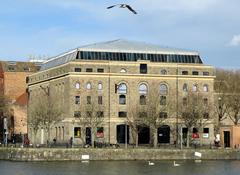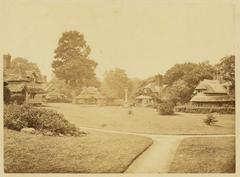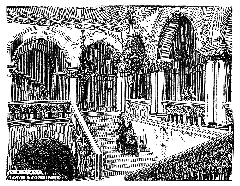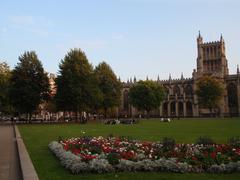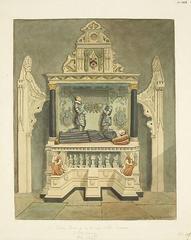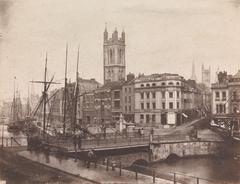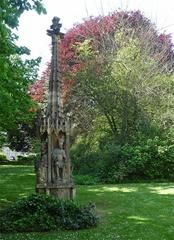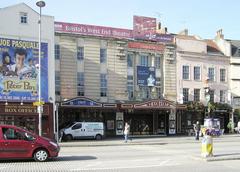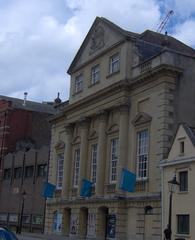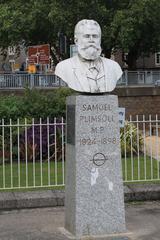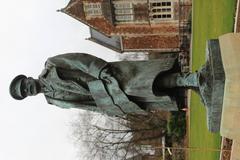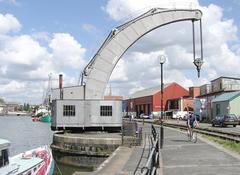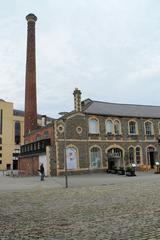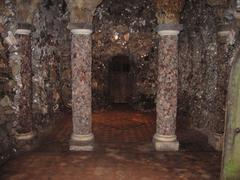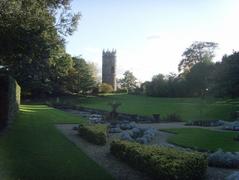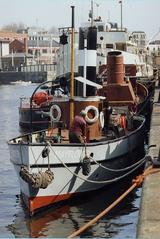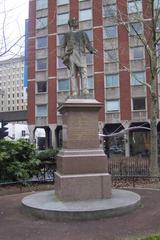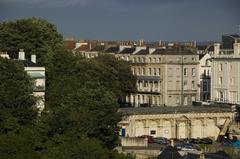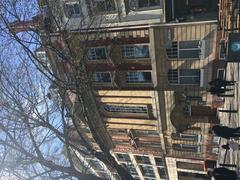Ashton Court Bristol: Visiting Hours, Tickets, and Travel Guide
Date: 15/06/2025
Introduction
Ashton Court Estate, just a short distance west of Bristol city centre, is one of the city’s most iconic landmarks. With a history stretching back nearly a thousand years, its transformation from a medieval estate to a cherished public park showcases the rich tapestry of Bristol’s heritage, landscape, and community spirit. From its first mention in the Domesday Book to its role as a vibrant venue for festivals, wildlife, and recreation today, Ashton Court is a must-visit destination for locals and tourists alike (Historic England; Epigram; TravelSetu).
Spanning approximately 850 acres, the estate is a designated Site of Special Scientific Interest (SSSI) thanks to its rare flora, ancient woodlands, and diverse fauna, including herds of deer and important bat species. The Grade I listed mansion, with its dramatic architectural evolution, stands at the heart of this historic landscape, offering a glimpse into centuries of English country life (Bristol City Council; WildBristol.uk; History Hit).
This comprehensive guide explores Ashton Court’s history, architecture, cultural significance, ecology, and practical visitor information—including visiting hours, tickets, accessibility, travel tips, and nearby attractions. Whether you’re interested in history, wildlife, festivals, or simply a beautiful day out, Ashton Court offers something for everyone.
Contents
- Early Origins and Medieval Foundations
- The Smyth Family Era: 16th to 20th Century
- Acquisition and Expansion
- Architectural Evolution
- Social and Economic Role
- 20th Century: War, Decline, and Public Ownership
- Wartime Requisition
- Transition to Public Ownership
- Restoration and Challenges
- Ashton Court in the Modern Era
- Public Park and Cultural Venue
- Festivals, Events, and Community Life
- Conservation and Sustainability
- Visitor Information: Planning Your Visit
- Visiting Hours and Tickets
- Directions and Parking
- Accessibility
- Travel Tips and Nearby Attractions
- Frequently Asked Questions (FAQ)
- Conclusion and Call to Action
Early Origins and Medieval Foundations
Ashton Court’s roots can be traced to the Domesday Book of 1086, which records it as a wealthy estate owned by the Bishop of Coutances (History Tools). Archaeological discoveries reveal human activity dating back to the Bronze and Roman ages, with well-preserved medieval field systems visible at the western edges of the park (Historic England). In the 14th century, the estate was enclosed as a deer park—a tradition that endures to this day.
The Smyth Family Era: 16th to 20th Century
Acquisition and Expansion
In 1545, John Smyth, a prominent Bristol merchant, purchased Ashton Court. The Smyth family’s stewardship over the next four centuries saw the estate expand and flourish, reflecting their status as influential local landowners (TravelSetu).
Architectural Evolution
The original manor house was transformed over generations. In the 17th century, major refurbishments under Thomas Smyth introduced stylistic influences from Inigo Jones. The house’s medieval core remains, but the building’s irregular plan and eclectic mix of styles—ranging from neo-Classical to Strawberry Hill Gothic—reflect centuries of architectural tastes (History Hit). Landscape improvements were influenced by Humphry Repton in the early 19th century, though his full vision was never realized due to the death of his patron (Historic England).
Social and Economic Role
The estate supported agriculture, hunting, and hospitality, with the mansion serving as a social hub for Bristol’s elite. The Smyths also preserved ancient trees, some now over 700 years old (Bristol City Council).
20th Century: War, Decline, and Public Ownership
Wartime Requisition
During the World Wars, Ashton Court was requisitioned for military use—serving as a hospital in WWI and as military headquarters in WWII (History Hit). These periods accelerated the decline of the mansion as a private residence.
Transition to Public Ownership
After the death of Dame Esme Smyth in 1946, the estate fell into disrepair. Bristol City Council purchased it in 1959, opening its gates to the public and marking a new era of community value (Historic England).
Restoration and Challenges
Restoration has been ongoing since the 1960s, but funding constraints mean that only parts of the mansion are currently restored and accessible. Community groups such as “Save Ashton Court Mansion” and Artspace Lifespace are actively involved in its preservation and adaptive reuse (BBC News; BristolWorld; Friends of Ashton Court Mansion).
Ashton Court in the Modern Era
Public Park and Cultural Venue
Since its public opening, Ashton Court has become Bristol’s premier green space, offering woodlands, meadows, and gardens for recreation and relaxation. The mansion is managed by Artspace Lifespace, which uses it for arts and community events (Epigram). While much of the interior remains closed due to safety concerns, the surrounding grounds are open year-round.
Festivals, Events, and Community Life
The estate is the site of many major events, most notably the annual Bristol International Balloon Fiesta, which attracts hundreds of thousands of visitors each August. Other events include ParkRun, open-air theatre, cycling festivals, and community gatherings (History Hit).
Conservation and Sustainability
Ecological stewardship is central to Ashton Court’s management. The estate preserves rare wildlife habitats and ancient trees, with conservation zones for wildflower meadows and protected species (Bristol City Council; History Tools).
Visitor Information: Planning Your Visit
Visiting Hours and Tickets
- Opening Hours: The estate grounds are open daily from dawn until dusk. Mansion opening hours vary and are typically limited to weekends or special events.
- Admission: Entry to the estate grounds is free. Some events and mansion tours may require a ticket (Bristol City Council; Friends of Ashton Court Mansion).
Directions and Parking
- Location: Approximately 3 miles west of Bristol city centre.
- By Car: On-site car parks (fees may apply during events).
- By Bus: Several routes serve nearby stops from Bristol city centre.
- By Bike: Cycle paths connect the estate to the city, with bike racks provided.
Accessibility
- Accessible paths and facilities are available throughout much of the estate.
- Some areas of the historic mansion may be inaccessible for wheelchair users; contact ahead for information.
Travel Tips and Nearby Attractions
- What to Bring: Comfortable shoes, binoculars for wildlife, picnic supplies.
- Nearby Attractions: Leigh Woods National Nature Reserve, Clifton Suspension Bridge, Bristol Zoo Gardens, and the Harbourside area.
Nature and Wildlife Highlights
Ashton Court is an ecological haven offering a mosaic of grasslands, wildflower meadows, and ancient woodlands (NatureFlip). Notable features include:
- Rare Orchids: Green-flowered helleborine and green-winged orchid (Botany Karen).
- Deer Herds: Red and fallow deer are kept in designated enclosures, while wild roe and muntjac deer may be seen in woodlands (WildBristol.uk).
- Birdlife: Marsh tits, woodpeckers, raptors, and migratory songbirds.
- Invertebrates: SSSI status is due in part to rare beetles dependent on deadwood habitats.
Responsible enjoyment and conservation are promoted—please stay on marked paths and keep dogs on leads in deer areas.
Events and Activities
- Bristol International Balloon Fiesta: Europe’s largest hot air balloon event (Visit Bristol).
- Ashton Court Miniature Railway: Family rides on select weekends (Visit Bristol).
- Sporting Activities: ParkRun, golf, disc golf, mountain biking, and horse riding.
- Family Fun: Play areas, deer viewing, nature trails.
- Seasonal Events: Summer fetes, autumn festivals, and Christmas markets.
Frequently Asked Questions (FAQ)
Q: What are Ashton Court’s opening hours?
A: Estate grounds open daily from dawn to dusk. Mansion hours vary; check the official website.
Q: Is there an entry fee?
A: Entry to the estate grounds is free. Certain events and mansion tours may require tickets.
Q: Are dogs allowed?
A: Yes, but must be on leads in deer areas and under close control elsewhere.
Q: Is Ashton Court accessible by public transport?
A: Yes, bus routes from Bristol city centre serve stops near the estate.
Q: Is the estate wheelchair accessible?
A: Most paths are accessible; some mansion areas are restricted due to historic features.
Conclusion and Call to Action
Ashton Court Estate is a living testament to Bristol’s history, ecology, and community life. Whether you’re attending a festival, exploring rare wildlife, or simply enjoying the scenic grounds, Ashton Court offers a unique experience for every visitor. Restoration and conservation efforts continue, aiming to ensure this landmark remains accessible and vibrant for future generations.
Plan your visit today:
- Check the latest visiting hours and event details via the Bristol City Council Ashton Court page.
- Download the Audiala app for self-guided tours and up-to-date event information.
- Explore nearby attractions and follow Ashton Court on social media for news and event updates.
Sources
- Epigram
- Historic England
- History Hit
- Bristol City Council
- TravelSetu
- NatureFlip
- Visit Bristol
- BristolWorld
- BBC News
- Friends of Ashton Court Mansion
- WildBristol.uk
